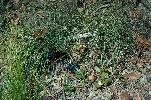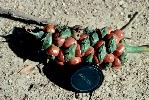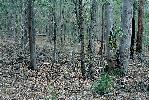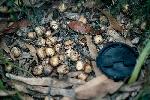Species profile—Macrozamia parcifolia
Classification
Plantae (plants) → Equisetopsida (land plants) → Zamiaceae → Macrozamia parcifolia

Go to Photo gallery
Species details
- Kingdom
- Plantae (plants)
- Class
- Equisetopsida (land plants)
- Family
- Zamiaceae
- Scientific name
- Macrozamia parcifolia P.I.Forst. & D.L.Jones
- WildNet taxon ID
- 6481
- Nature Conservation Act 1992 (NCA) status
- Vulnerable
- Environment Protection and Biodiversity Conservation Act 1999 (EPBC) status
- Vulnerable
- Conservation significant
- Yes
- Confidential
- Yes
- Endemicity
- Native
- Pest status
- Nil
- Short Notes
- Gymnosperm, two sheets plus spirit and carpological
- Description
- Macrozamia parcifolia has an unbranched underground stem that is 10-20cm in diameter, and a crown of 1-4 erect dark green leaves 65-95 cm long, and hairless, except for the wool at the base. Each leaf consists of 100-220 leaflets arranged along a spirally twisted (2-6 times) rhachis (central stalk). The very narrow leaflets measure 15-40cm long by 1-3mm wide, are dark green and dull above and bright green below, with a slightly thickened greenish-white base.
The plant reproduces by cones which are somewhat pineapple-like in appearance. Male and female cones develop on separate plants. Male cones are cylindrical, 7-14cm long and 2.5-4cm in diameter, curved with age. Female cones are ovoid (egg-shaped), 8-14cm long and 4-6cm in diameter. Seeds are ovoid (egg-shaped), 1.7-2.5cm long, 1.5-2cm in diameter and orange to red when ripe.
Macrozamia parcifolia is easily distinguished from the related M. pauli-guilielmi by the narrower, thinner-textured, darker green leflets which are attached to the rhachis at an angle of 30 degrees. (Jones & Forster 1994; Halford 1995; Hill 1998; DEWHA 2008) - Map
- View Map
- Habitat
- Macrozamia parcifolia occurs in tall open forest communities with a sparse to dense shrubby understorey, at altitudes between 120-220m above sea level. It grows on stony ridges and slopes, on well-drained, hard, red-brown clay loam soils of basaltic origin. (Halford 1995; DEWHA 2008)
- Behaviour
- Adult Macrozamia plants have an underground stem and are able to resprout after loss of the above-ground foliage from fire. Seedlings and unburied seeds are usually killed by fire. Synchronous cone formation often follows fire. (Halford 1995; Queensland Herbarium 2007)
- Reproduction
- Cones are produced from October to January and ripe seeds occur from February to April. Cones may not be produced annually when conditions are unfavourable. Cross-pollination between individual Macrozamia conferta plants is thought to be effected by a species of Tranes weevil in an obligate mutualism. (Forster et al. 1994; Halford 1995)
- Predators
- Like most other Macrozamia species, the leaves of M. parcifolia are highly toxic when eaten by domestic stock. (Halford 1995; Queensland Herbarium 2007)
- Management documents
- Conservation and management of protected plants in trade in Queensland 1995-1998. Department of Environment.
- Notes
- Contributors: Ailsa Holland, Mellisa Mayhew 18/06/2009
- References
- Department of the Environment, Water, Heritage and the Arts (2008). Macrozamia parcifolia in Species Profile and Threats Database, Department of the Environment, Water, Heritage and the Arts, Canberra. Accessed 08/10/2008.
Forster, P.I., Machin, P., Mound, L. & Wilson, G. (1994). Insects associated with the reproductive structures of cycads in Queensland and north-east New South Wlaes, Australia. Biotropica 26: 217-222.
Halford, D. (1995). Macrozamia parcifolia, in Species Management Manual. Department of Natural Resources, Brisbane.
Herbrecs (2008). Macrozamia parcifolia, in BriMapper version 2.12. Queensland Herbarium. Accessed 08/10/2008.
Hill, K.D. in McCarthy, P.M. (Ed) (1998). Flora of Australia 48: 653.
Jones, D.L. & Forster, P.I. (1994). Seven new species of Macrozamia section Parazamia (Miq.) Miq. (Zamiaceae section Parazamia) from Queensland. Austrobaileya 4(2): 279. - Profile author
- Ailsa Holland (18/06/2009)
Other resources
- Species Profile and Threats Database (SPRAT)
- The Australasian Virtual Herbarium (AVH)
- Atlas of Living Australia
Data source
This profile data is sourced from the QLD Wildlife Data API using the Get species by ID function used under CC-By 4.0.
https://apps.des.qld.gov.au/species/?op=getspeciesbyid&taxonid=6481.
This information is sourced from the WildNet database managed by the Queensland Department of Environment and Science.








